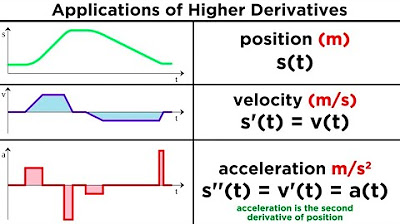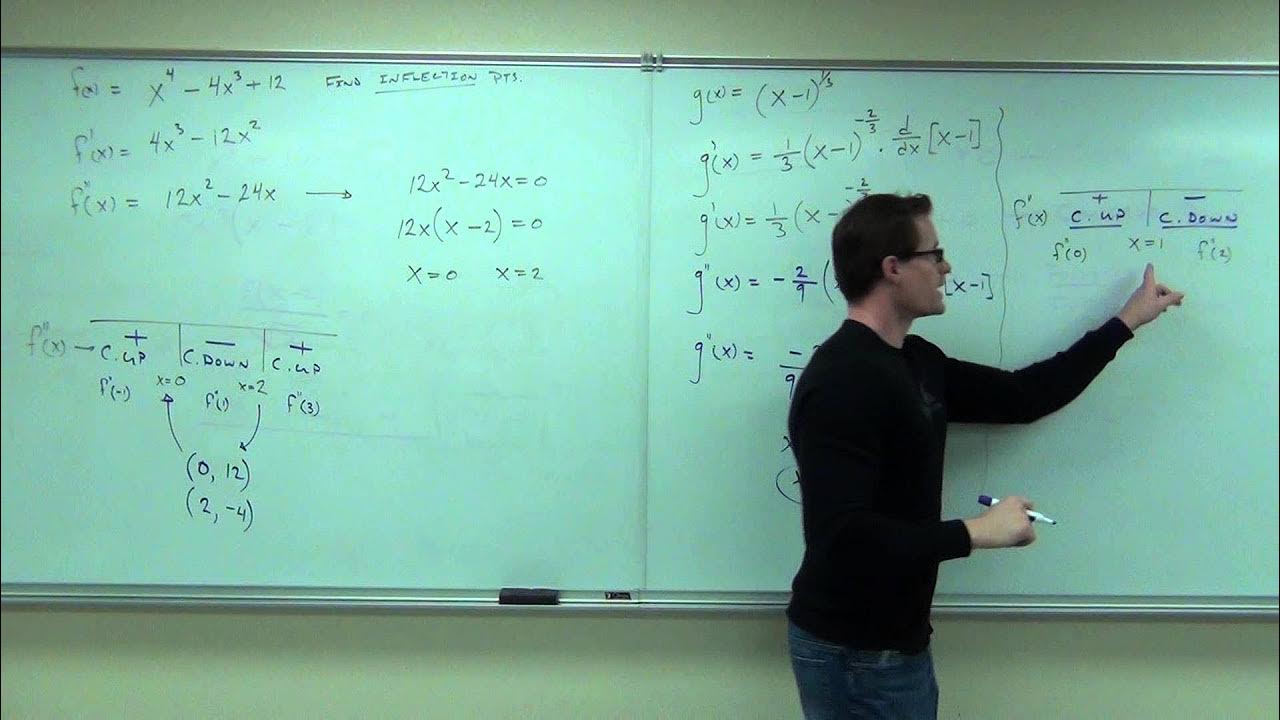Higher order derivatives | Chapter 10, Essence of calculus
TLDRThis script introduces higher order derivatives, focusing on the second derivative to explain its significance in the context of graphs and motion. The second derivative, denoted as d²f/dx², measures how the slope of a function changes, indicating whether the function is curving upwards (positive) or downwards (negative). It is also related to acceleration in physics, with the third derivative known as 'jerk', which signifies changes in acceleration. The script highlights the utility of higher order derivatives in approximating functions, setting the stage for the upcoming discussion on Taylor series.
Takeaways
- 📚 The next chapter will focus on Taylor series and frequently reference higher order derivatives.
- 🚀 If you're already familiar with second, third, and higher order derivatives, you can skip ahead to the main content.
- 🔍 The script introduces higher order derivatives for those who haven't encountered them yet, aiming for completeness.
- 📈 The first derivative of a function can be interpreted as the slope of the graph at a point, with steepness indicating the derivative's value.
- 📉 The second derivative is the derivative of the first derivative, indicating how the slope is changing.
- 📊 A positive second derivative at a point means the slope is increasing, suggesting upward curvature of the graph.
- 📈 Conversely, a negative second derivative indicates the slope is decreasing, showing downward curvature.
- 📝 The notation for the second derivative is typically written as \( \frac{d^2f}{dx^2} \), representing the rate of change of the first derivative.
- 🔧 The concept of second derivative can be understood through the analogy of a function's change over small increments of \( x \).
- 🏎 In the context of motion, the second derivative represents acceleration, showing how the velocity is changing over time.
- 🤔 The third derivative, humorously called 'jerk', indicates changes in the strength of acceleration.
- 🛠 Higher order derivatives are useful in approximating functions, which is a key topic in the upcoming discussion on Taylor series.
Q & A
What is the primary interpretation of the derivative of a function?
-The derivative of a function can be interpreted as the slope of the graph of the function at a given point. A steep slope indicates a high value for the derivative, while a downward slope means a negative derivative.
What does the second derivative represent?
-The second derivative represents the derivative of the derivative, which means it tells you how the slope of the function's graph is changing. It indicates whether the slope is increasing or decreasing.
How can you visually determine the sign of the second derivative from the graph of a function?
-At points where the graph curves upwards, the slope is increasing, indicating a positive second derivative. Conversely, at points where it curves downwards, the slope is decreasing, indicating a negative second derivative. If there's no curvature, the second derivative is zero.
What is the standard notation for the second derivative?
-The standard notation for the second derivative is d²f/dx², which is an abbreviation for the derivative of the derivative function with respect to x.
Can you explain the concept of 'ddf' in the context of the second derivative?
-The 'ddf' refers to the difference in the change of the function after taking two small steps to the right, each of size dx. It represents the change in how the function changes and is proportional to the square of the size of dx (dx²).
How does the second derivative relate to the concept of acceleration in physics?
-The second derivative is analogous to acceleration in physics. Given a function that records distance traveled versus time, the second derivative represents the rate at which the velocity (the first derivative) is changing.
What is the term used for the third derivative of a function?
-The third derivative of a function is called 'jerk'. It represents the rate at which the acceleration (the second derivative) is changing.
What is the practical application of higher order derivatives in approximating functions?
-Higher order derivatives are useful in approximating functions because they provide information about the behavior of the function beyond just the slope and curvature. They help in understanding the rate of change of these properties, which is essential in techniques like Taylor series expansion.
How does a positive second derivative affect the motion of an object?
-A positive second derivative indicates that the object is speeding up, as it suggests that the velocity is increasing. This can be felt as a sensation of being pushed back into a car seat or having the car seat push you forward.
What does a negative second derivative signify in terms of motion?
-A negative second derivative signifies that the object is slowing down, which means the velocity is decreasing. This is also referred to as negative acceleration.
How does the concept of 'jerk' relate to the physical world?
-In the physical world, 'jerk' is the third derivative of a function that describes motion. If the jerk is not zero, it means that the strength of the acceleration is changing, which can be felt as a change in the pushing or pulling force acting on an object.
Outlines
📈 Understanding Higher Order Derivatives
This paragraph introduces the concept of higher order derivatives, specifically focusing on the second derivative. It explains the second derivative as the derivative of the derivative, which indicates how the slope of a function's graph is changing. The text uses visual analogies, such as the curvature of the graph and the direction of the slope, to illustrate when the second derivative would be positive, negative, or zero. Notation for the second derivative is also discussed, with a step-by-step explanation of how to interpret the standard notation \( d^2f/dx^2 \). The concept of acceleration as it relates to the second derivative in the context of motion is introduced, and the third derivative, humorously referred to as 'jerk,' is mentioned as a measure of how the acceleration is changing. The paragraph concludes by highlighting the importance of higher order derivatives in approximating functions, which is a topic that will be further explored in the next chapter on Taylor series.
🔍 Approximating Functions with Higher Order Derivatives
The second paragraph briefly mentions the utility of higher order derivatives in approximating functions, which is the main subject of the upcoming chapter on Taylor series. It serves as a transition, indicating that the detailed exploration of how higher order derivatives aid in function approximation will be covered in the next chapter. This paragraph acts as a teaser, building anticipation for the material to come and reinforcing the significance of the concepts introduced in the first paragraph.
Mindmap
Keywords
💡Taylor series
💡Higher order derivatives
💡Second derivative
💡Derivative
💡Graph
💡Slope
💡Motion
💡Velocity
💡Acceleration
💡Jerk
💡Approximation
Highlights
Frequent reference to higher order derivatives in the next chapter on Taylor series
If comfortable with second, third derivatives, feel free to skip ahead
Higher order derivatives not discussed yet in the series
Quick overview of higher order derivatives for completeness
Focus on second derivative in context of graphs and motion
Derivative interpreted as slope of graph above a point
Second derivative is derivative of the derivative, tells how slope is changing
Second derivative positive when graph curves upward, negative when curving downward
Second derivative = 0 when no curvature
Notation: d^2f/dx^2 for second derivative
Intuition for second derivative through small steps and changes in function
Second derivative represents acceleration in distance vs time graphs
Third derivative called jerk, measures how acceleration itself is changing
Higher order derivatives useful for approximating functions
Second derivative positive = speeding up, negative = slowing down
Taylor series chapter will explore higher order derivatives further
Transcripts
Browse More Related Video

Calculus - Lesson 11 | Derivative as a Function | Don't Memorise

Higher Derivatives and Their Applications

BusCalc 18 Second Derivatives

Higher Derivatives and Concavity

Calculus 1 Lecture 3.4: The Second Derivative Test for Concavity of Functions

Lesson 6 - Higher Derivatives in Calculus (Calculus 1 Tutor)
5.0 / 5 (0 votes)
Thanks for rating: